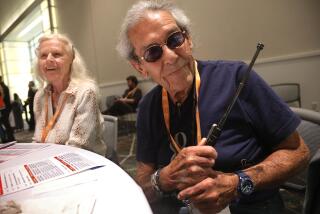Passengers Feel Threat of Rail Strike
- Share via
Travelers started to feel the pinch of an impending nationwide railroad strike as Amtrak on Monday canceled long-distance train service, shunted passengers to buses and prepared to halt operations altogether.
Commuter and freight traffic could stop at 9:01 tonight, the end of a 30-day, congressionally mandated cooling-off period, unless the railroads and unions can settle three contract conflicts.
Although the unions involved represent only about 9% of all railroad workers, and national union leaders said they may not withdraw all of their members at midnight New York time, other unions are likely to honor any picket line that does pop up.
Faced with the possibility that regional strikes could snowball into a nationwide walkout, negotiators raced to beat the deadline Monday evening. However, neither side was optimistic about a timely settlement of the four-year dispute.
Suspension of commuter service would affect 6,000 riders from Orange and San Diego counties into Los Angeles, and 600,000 people across the nation. Most commuter train services are locally owned, but rely on Amtrak crews, equipment or stations.
Amtrak officials said they did not plan to offer an alternative to the San Diegan service, which carries the bulk of the rail service’s Southern California commuters. Unless the strike is postponed, they said, the last San Diegan train from Los Angeles to Orange County and San Diego will leave Union Station at 6:20 tonight.
The Orange County Transportation Authority said it will use buses to replace service canceled by a strike, but only on its lone round-trip commuter run between San Juan Capistrano and Los Angeles. Inbound service leaves San Juan Capistrano at 6 a.m., with intermediate stops in Irvine and Santa Ana. Outbound service leaves Los Angeles at 5:40 p.m.
At issue are three contracts. One is between Amtrak and six unions. The second pact is between the International Assn. of Machinists and Aerospace Workers and the five largest freight carriers. The third is between the Brotherhood of Maintenance of Way Employees and Conrail, a freight line operating in the Northeast.
Cancellation of Amtrak’s long-distance service led to chaos, confusion and anger at some of the nation’s passenger terminals. At Union Station in Los Angeles, travelers expecting to board the Chicago-bound Desert Wind at 11:50 a.m. were instead loaded onto charter buses bound for Las Vegas.
Once there, Amtrak officials said, they could transfer to other charter buses and continue to Denver, but were unlikely to get beyond the Colorado capital before the strike deadline passed and Amtrak stopped all service.
“I am very angry,” said Gigi Hollabough of Santa Clarita, who was taking her 10-year-old daughter, Gretchen, to meet relatives. “If they go on strike while we are in Las Vegas, they said they could not bring us back--by bus or train or anything else.”
She said she arranged to return by Greyhound bus if Amtrak is not operating.
A family of eight headed for a family reunion in Iowa said they would go as far as train or bus would take them, then rent a van to complete the trip. John Dennis of Lakewood sent three daughters on a trip to his brother’s house in the Central Valley town of Turlock, knowing he may have to drive there on Sunday to retrieve them if the strike hits.
Ray and Martha Welch had just arrived in Los Angeles on the Sunset Limited from New Orleans and were hoping to take the Desert Wind to San Bernardino to visit relatives.
“What bothers me,” said Ray, who is retired and lives in Charleston, S.C., “is that they are not very forthcoming in the station. The train is still listed on the departure board, and (Amtrak personnel) are hiding in a little room behind the information booth.”
He said he had to call Amtrak’s toll-free information line--1-800-USA-RAIL--to learn that his train had been canceled. A ticket agent told him where to find the bus used in its place.
But the situation was equally muddled in the bus bays south of the station, where only one of six buses had a destination sign, and no Amtrak personnel were present to help 200 passengers.
Some dragged their luggage from bus to bus, looking for drivers to reveal the destinations. Others milled about, frustrated and angry, while their children wailed. The Desert Wind was to have left before noon, but its replacement buses did not roll until after 1 p.m.
“You taking complaints?” one woman asked a bystander with a notebook. “We’ve got plenty to give you.”
Entering negotiations Monday, union leaders sought to appear resolute and reasonable. Seeking to resist wage and work rule concessions sought by the railroads without triggering a congressional back-to-work order, they said they may not strike when the cooling-off period expires.
“We’ll strike on our own timetable,” said Jed Dodd, general chairman of the Pennsylvania Federation of the Brotherhood of Maintenance of Way Employees and the unions’ chief negotiator. Walkouts may also be limited to certain regions.
The unions are seeking to avoid provoking Congress to enter the dispute, as it did in 1991, legislatively imposing a compromise on both sides and squashing a nationwide strike by another set of railroad unions only 19 hours after they had walked off the job.
A similar compromise to end this dispute, equally distasteful to the unions, has been proposed by an emergency board. Intended to serve as a negotiating catalyst, the compromise is not binding unless Congress makes it so.
More to Read
Sign up for Essential California
The most important California stories and recommendations in your inbox every morning.
You may occasionally receive promotional content from the Los Angeles Times.













